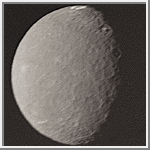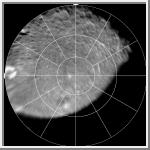
Uranus II
Umbriel [UM-bree-ul] is the darkest satellite of Uranus. It is about the same size as Ariel and has about the same density. The surface appears to be old with large craters and does not change much from one location to another. Near the top is a puzzling bright ring called the fluorescent cheerio. It is probably the floor of a crater.
| Umbriel Statistics | |
|---|---|
| Discovered by | William Lassell |
| Date of discovery | 1851 |
| Mass (kg) | 1.27e+21 |
| Mass (Earth = 1) | 2.1252e-04 |
| Equatorial radius (km) | 584.7 |
| Equatorial radius (Earth = 1) | 9.1675e-02 |
| Mean density (gm/cm^3) | 1.52 |
| Mean distance from Uranus (km) | 265,970 |
| Rotational period (days) | 4.144177 |
| Orbital period (days) | 4.144177 |
| Mean orbital velocity (km/sec) | 4.67 |
| Orbital eccentricity | 0.0050 |
| Orbital inclination (degrees) | 0.36 |
| Escape velocity (km/sec) | 0.538 |
| Visual geometric albedo | 0.18 |
| Magnitude (Vo) | 14.81 |
 Umbriel
Umbriel
The surface of Umbriel
appears to be old with large craters and does not change much from one
location to another. Near the top is a puzzling bright ring called
the fluorescent cheerio. It is probably the floor of a crater.
(Credit: Calvin J. Hamilton)
 Southern Hemisphere of Umbriel
Southern Hemisphere of Umbriel
This image is a polar stereographic projection of the southern
hemisphere of Umbriel. Zero degrees longitude is located at the top.
(Courtesy A. Tayfun Oner)
 Albedo Map of Umbriel
Albedo Map of Umbriel
This image is an adaptation of a figure from an article by Paul
Helfenstein, Peter C.Thomas and Joseph Veverka published in the March 23,
1989 issue of Nature. The color image is an albedo map of Umbriel after
shading correction and contrast enhancement. Dark regions are
represented as red and bright regions are represented as blue. The two
white regions are bright ejecta from two fresh craters. In the article
the authors suggested that the dark areas are the result of an internally
driven resurfacing event early in Umbriel's history involving darker
material. Similar ice volcanism is also seen on Miranda,
Ariel, and possibly on Oberon.
They also state that the limited data also hint that the darker regions are
lower in elevation.
(Courtesy A.Tayfun Oner)

 Uranus
Uranus Ariel
Ariel Titania
Titania